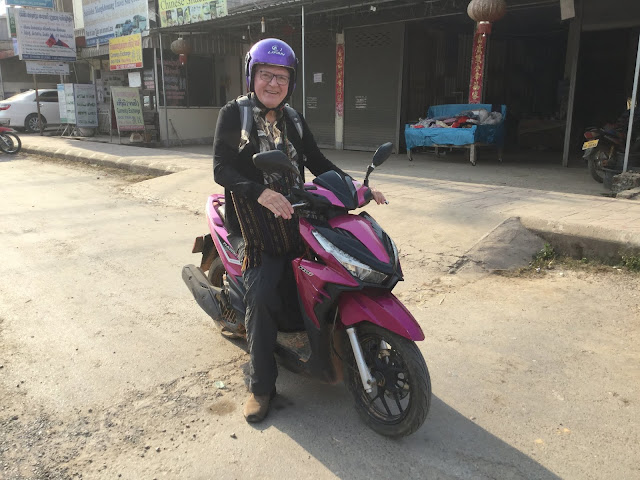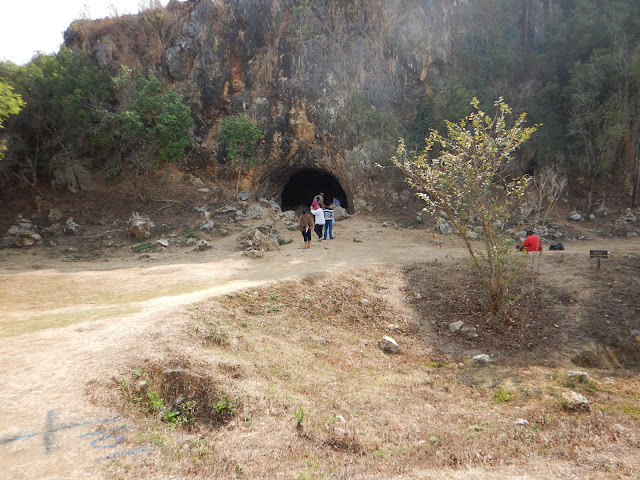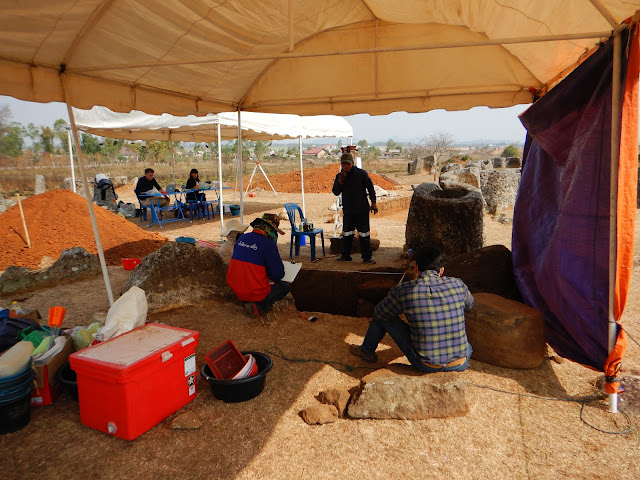I was eager to set out in my hot pink motor scooter for the Plain of Jars at a cost of 100,000 kip—$11USD. It was good the traffic was light as I learned how to operate this automatic scooter. Using map.me, I navigated my way easily to Site 1 of the Plain of Jars.
While there are many theories about the use and origins of these crafted jars from solid stone ranging from sandstone to granite, some believe they put dead people inside or their cremated remains, used it for fermenting rice, and storing rice.
Site 1 has over 250 such jars amidst many bomb craters left by the US during the Vietnam War. There are war trenches when the fighting got intense. Many of the jars were broken during the severe bombing.
About 350 people were killed when a bomb went off just outside the cave they were hiding in. The bomb crater is in the foreground.
I preferred to focus on the group of monks at this cave rather than the war actions. Before the Vietnam deaths, they believe that this was used as a crematorium, and then the remains were placed in some jars.
They are currently running an archeological research project here and have found human remains, small beads, and other artifacts. They estimate these objects are around 2,000 years old. Research has been slowed by the need to remove unexploded bombs (UXO). They estimate that 30% of the bombs dropped went unexploded creating a gigantic hazard even today with 80 million UXO yet to be found in Laos. At Site 1 they have found 127 UXOs so far—I stayed on the marked trails.
They have a very good museum as you get your tickets, which explains a lot about the Plain of Jars and that more bombs were dropped in Laos than during the entire WWII.
I would cross paths a few times with Michael who headed out after I did.
After missing the cutoff for Site 2, I found my way back to it. After paying the entry fee, I drove up a gravel road to the parking area and then walked up a tree-covered area where the jars were strewn about. It was a beautiful setting with the moss, lichen, and liverwort covering most parts of these jars. Some were broken from nearby bomb blasts just like at Site 1.
On the more open hill across the way were other clusters of jars.
I then made my way back down to the motorbike and headed down to the right following the signage. After a few km, the road turned to gravel for the next 6 km.
There was a sign of a waterfall that was just 1 km down a different road and I took that only to be disappointed that the waterfall had dried up—the Laotian guide told me it was because the Chinese had dammed up the river for power.
I backtracked to the crossroads and stopped for some lemon tea and went another 4 km on more gravel roads. I missed the sign to Site 3, but when I shortly got back on the paved road, Micheal was coming in the opposite direction so he guided me to Site 3.
After paying our entrance fee we walked over a bamboo bridge and crossed a number of dry rice paddies and these water buffalo until we started up a hill into a cluster of trees where we found Site 3 jars.
Here we were met by a small group with a guide who told me about the Chinese damming up the rivers for power.
One of the cracked-open jars was perfect for a corny photo op.
Micheal decided to have lunch at the Site 3 restaurant and I headed back to town to find out about bus arrangements to Vinh, Vietnam, drop a postcard off at the post office while it was still open, and exchange some Baht for Kip.
When I got to the bus station, I learned that the International Bus from Phonsavanh to Vinh, Vietnam had been canceled for the last two days as well as would be canceled on Friday. He said if I came back on Saturday, they might go.
I figured that was too iffy so I decided to get a local bus to Nong Het which was as far as any bus would go toward the border between Laos and Vietnam. Once in Nong Het I would try to find a jumbo, motorbike, or tuk-tuk to take me the additional 14 km to Nam Khan, Laos and Nam Can, Vietnam.
At the local bus station just up the street from my Nice Hotel, I walked around trying to find out how to get a local bus ticket and people told me to just show up by 7 am in the morning.
On the way back I found this seamstress repairing the torn inner pocket of my Chiang Mai man bag.
When I got to my hotel, the manager got me a ticket for 60,000 kips and told me to be in the lobby at 6:40 for a ride over to the station and that driver would get me on the right bus.
Subscribe to My YouTube Channel
I have recently uploaded all of my travel videos to YouTube now that they allow longer uploads and you may want to see my travel adventures there. That link is
https://www.youtube.com/c/huntforgold.
If you do go there, please subscribe to my video channel since it will help me eventually get some income there and help with my future travels.
























No comments:
Post a Comment